Karanji Recipe (Kajjikayalu)
Updated: August 28, 2022, By Swasthi
Karanji also known as Kajjikayalu are deep fried sweet dumplings made with a filling of coconut, powdered sugar and nuts. These are simply delicious & are an addictive festive treat made during Ganesh Chaturthi, Diwali, Sankranti and Holi. Karanji is the Maharashtrian name for this fried dumpling or fried pastry and is also known by different names such as gujiya, kajjikayalu, karjikayi & sweet somas in different regions of India. Each of these have a slightly different filling.
In this post I share the recipe to make karanji, which is the same as Andhra Kajjikayalu.
Gujiya is made majorly with a filling of mawa & nuts, the Karnataka style karjikayi is made with fried gram flour, coconut and poppy seeds and the sweet somas are made sometimes with rava and sometimes with fried gram, coconut, seeds and nuts.
However there are no hard and fast rules to follow, the ingredients used for stuffing is more of a personal choice. Every family has a different recipe for the stuffing. I am sharing the recipe which Mom would make for us.
Sometimes she would also add roasted semolina for crunch or roasted & crushed peanuts to the same.
About Karanji
To make karanji, a pastry dough made with all-purpose, semolina & ghee is made first. A sweet filling is prepared by roasting desiccated coconut, and nuts briefly, to which powdered sugar or jaggery is added.
Some variations use poppy seeds and sesame seeds too for the filling. The filling is flavored with ground cardamom & nutmeg (optional).
The dough is rolled to flat discs like small puris and then filled with the prepared sweet coconut. Karanji is shaped to half-moon and are sealed on the edges to safe the filling.
These are deep fried in oil until crisp, golden and flaky.
The process to make these may seem long and yes they do take time but are easy to make. It is always good to have a helping hand while you make these. If you are a person with fast and multitasking abilities you can make them alone, without help.
To make the entire take easier, I usually make the filling ahead but mix the powdered sugar only when I am ready to shape the karanji.
What better time to make these other than during festivals? I know these are extremely delicious and additive and anyone would want to enjoy them all-round the year.
If this is your first time making these karanji, do read my pro tips and faqs below so you get the best results out of this recipe.
You may like to check this collection of 100 diwali sweets recipes and these diwali snacks recipes.
Popular sweets recipes
Gulab jamun
Rasmalai
Kaju katli
Rasgulla
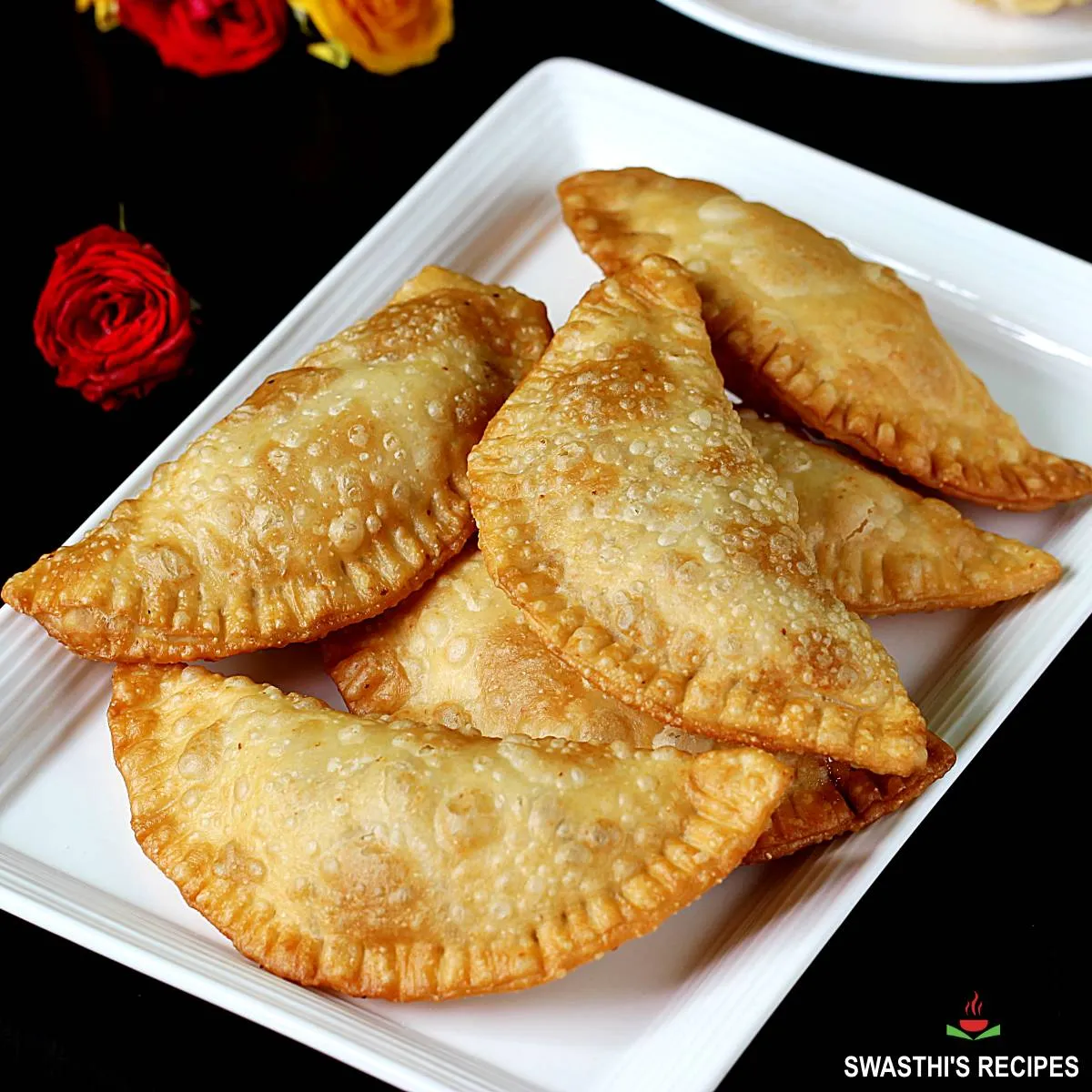
Photo Guide
How to Make Karanji (Stepwise Photos)
Make Dough
1. Measure ½ cup dried coconut (copra), ¼ cup chopped cashews,½ cup sugar, 1 tablespoon poppy seeds (optional), ¼ teaspoon cardamom powder and a pinch of nutmeg powder (optional). Keep all these aside.
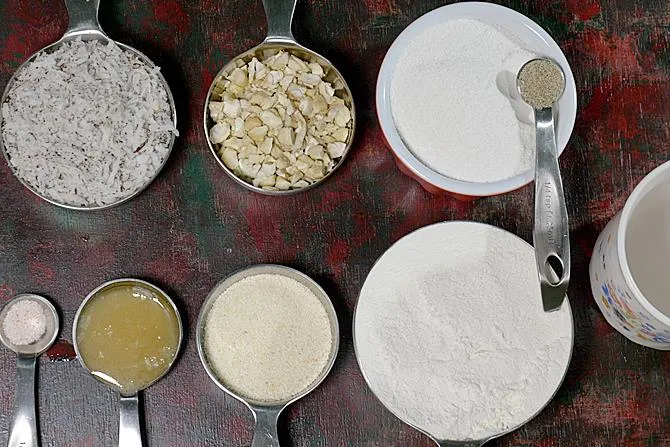
2. To make the outer covering, to a large mixing bowl, add 1 cup organic all-purpose flour (maida), 2 tablespoons semolina (rava) and a pinch of salt. Heat 2 tablespoons ghee in your deep frying kadai and pour it here. Mix everything well.
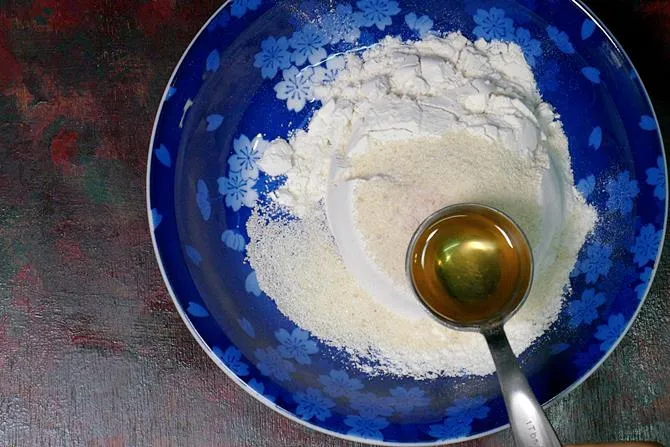
3. Add ⅓ cup warm water. Be careful not to add more else the dough will turn sticky and soak up oil while frying.
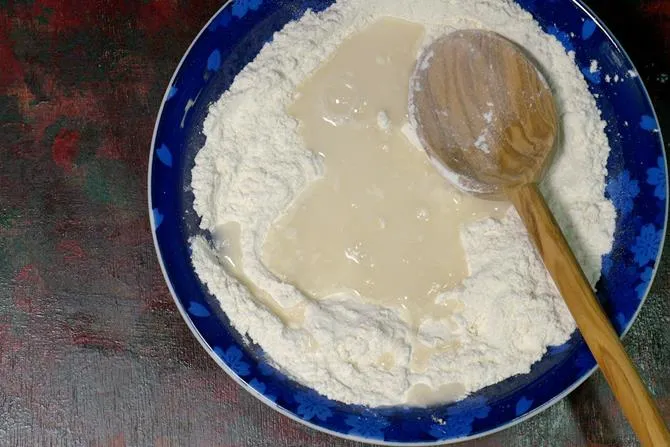
4. Mix and make a tight dough, adding more water if required. The dough has to be soft yet non sticky. Do not over knead it. Keep this covered and set aside until the filling is ready.
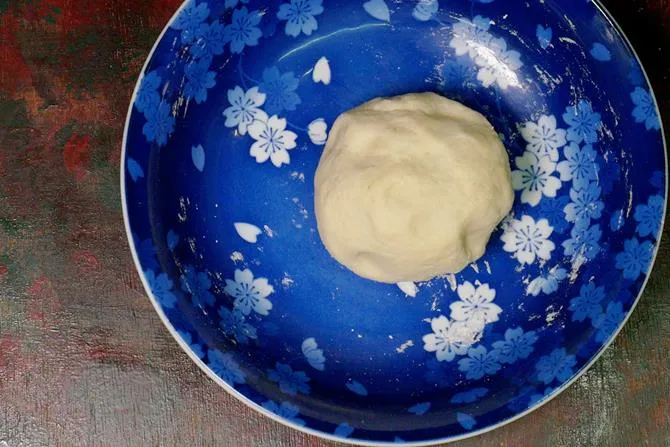
Make Filling
5. Fry ¼ cup chopped cashews (or mixed nuts) in 1 teaspoon ghee.
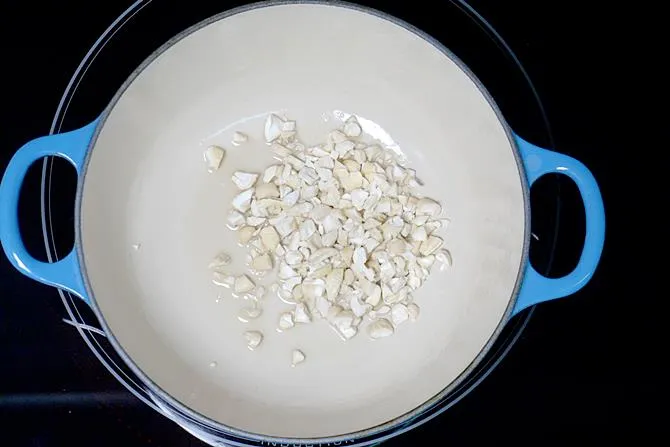
6. When the cashews are lightly roasted add coconut. Fry on a medium heat just for 1 to 2 mins or until the mixture turns hot.
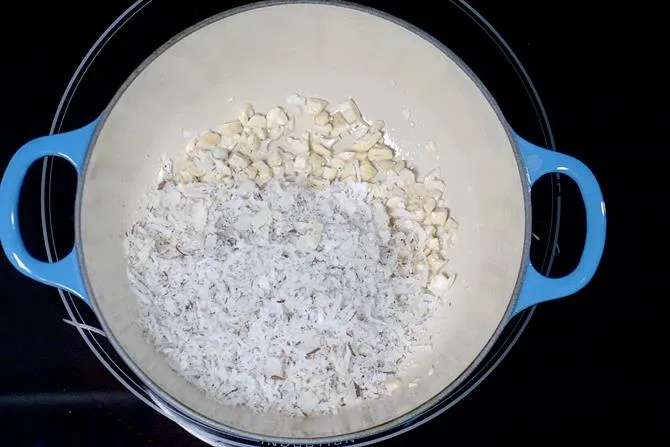
7. Add cardamom powder and nutmeg. Turn off the stove. Mix and transfer this to a large bowl for cooling.
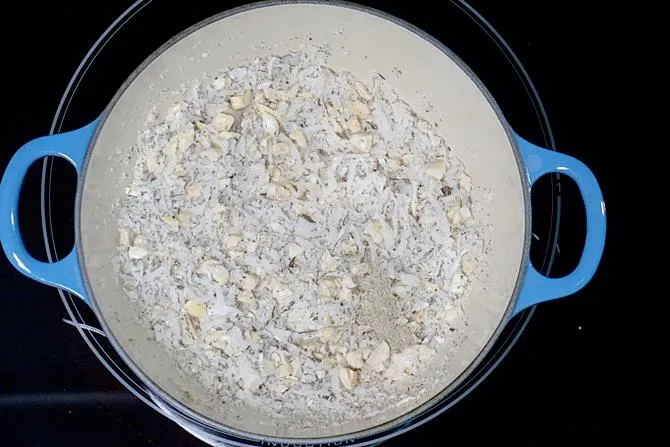
8. Meanwhile add half cup sugar to a grinder jar and powder it. Once the coconut cools down completely, add powdered sugar & mix. You can adjust the sweetness to your liking. For less sweeter karanji you may start with lesser sugar powder. We have a sweet tooth so I use all of the powdered sugar. Also note that the outer covering is unsweetened so I make the filling on the sweeter side.
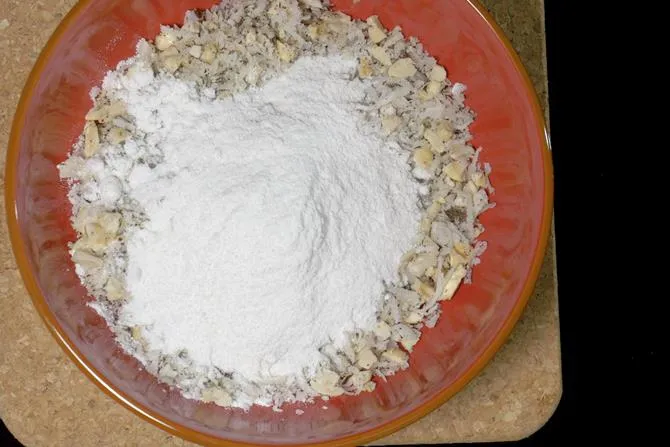
Shape Karanji
9. Divide the dough to 10 to 12 equal parts.Begin to roll a ball on the rolling area. I didn’t use any flour or oil. You may lightly grease the board if required.
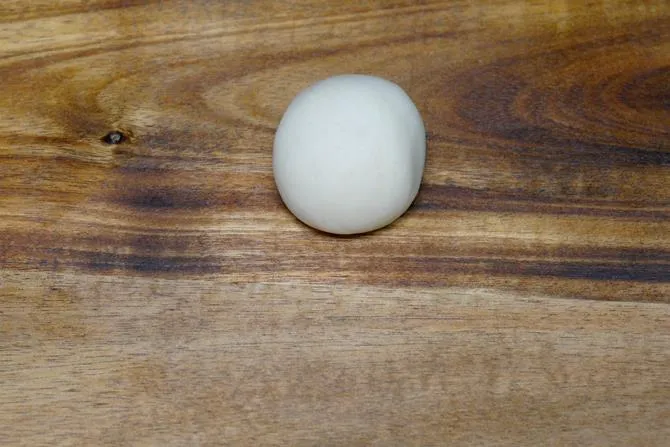
10. Make a thin puri about 5 inches in size. Add 1½ to 2 tbsp of sweet filling to the center. If you make thick puri your karanji will not turn crispy, it has to be medium thick. Dip your finger in a bowl of water and smear it all over the edges of the puri.
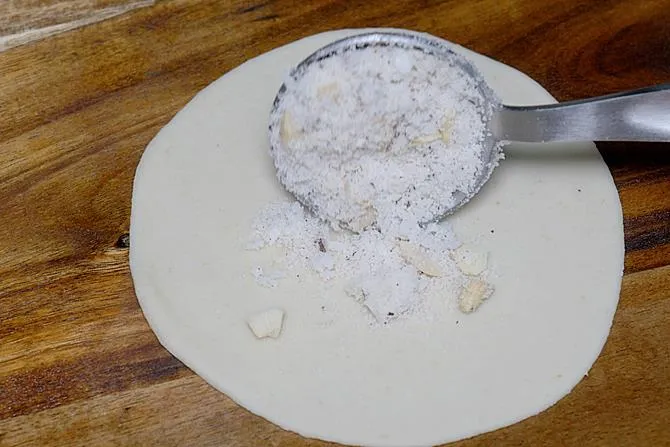
11. Cover it like you see in the picture. Seal the edges by pressing both the layers. Make sure the karanji is sealed properly else they will open up in the oil while frying. You can make about 4 karanji first and begin to fry while you make the rest. Do not allow them to dry up. Keep them covered with a moist cloth.
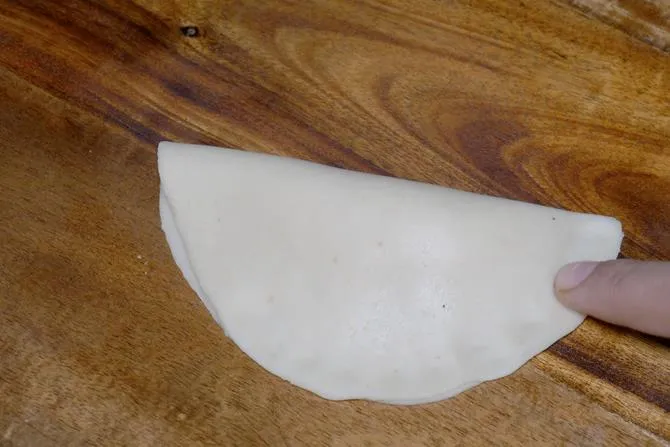
12. Using a fork gently press towards the edge to make a light design.
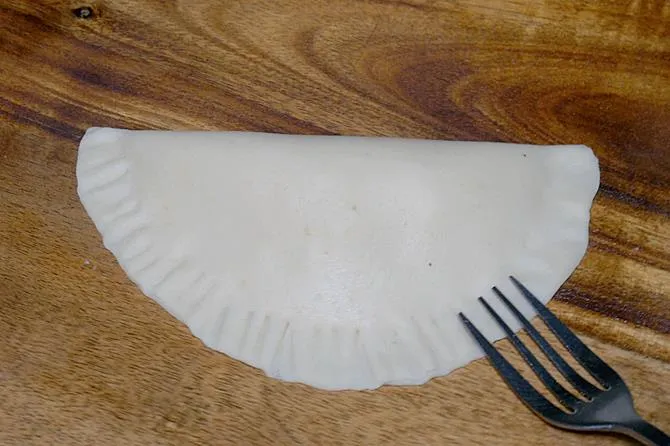
Deep Fry
13. Heat oil for deep frying on a medium heat. To check if the oil is of the right temperature, add little dough to the pan. It has to rise without turning brown. If it sinks, it means the oil is not hot enough. Let the oil heat well. Also make sure it is not smoking hot, else the karanji will brown before the covering fries to crisp texture.
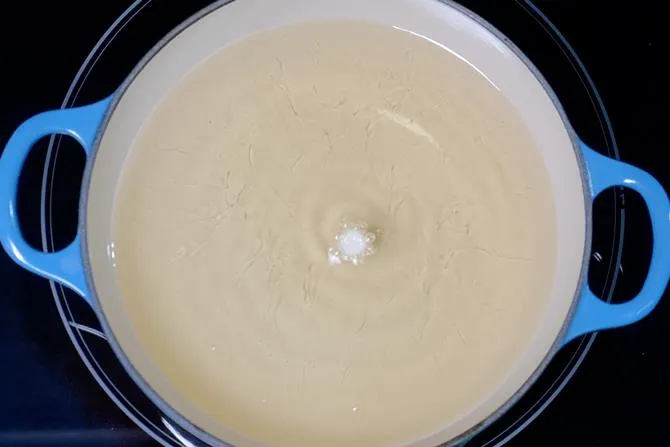
14. Gently drop karanji in hot oil and do not disturb them for few minutes. Turn them and fry on both the sides. They will puff up while frying. On a medium heat fry them until golden and crisp.
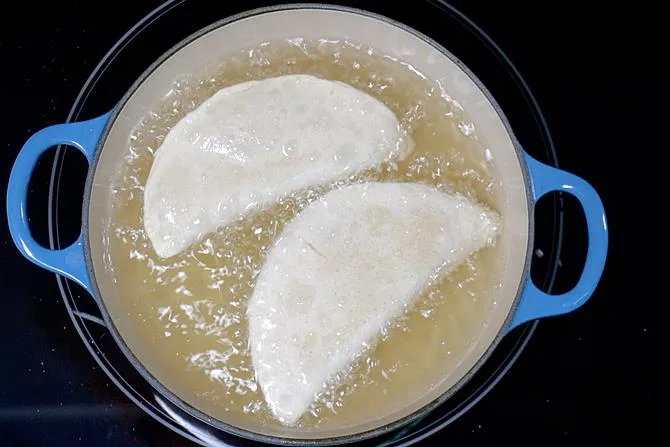
15. Remove them to a cooling rack or a steel colander.
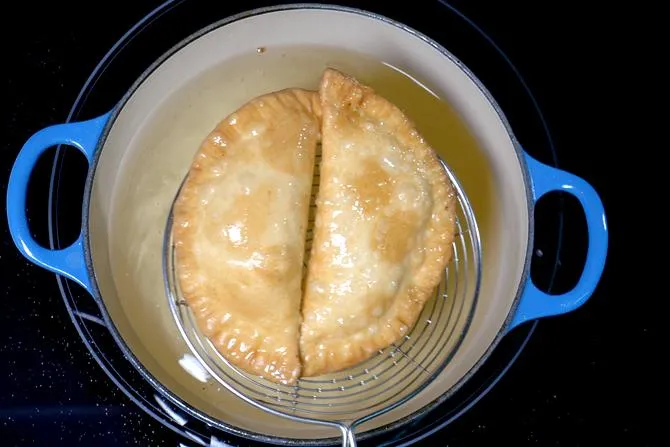
Cool karanji completely and store in a clean steel air tight container for 2 weeks.
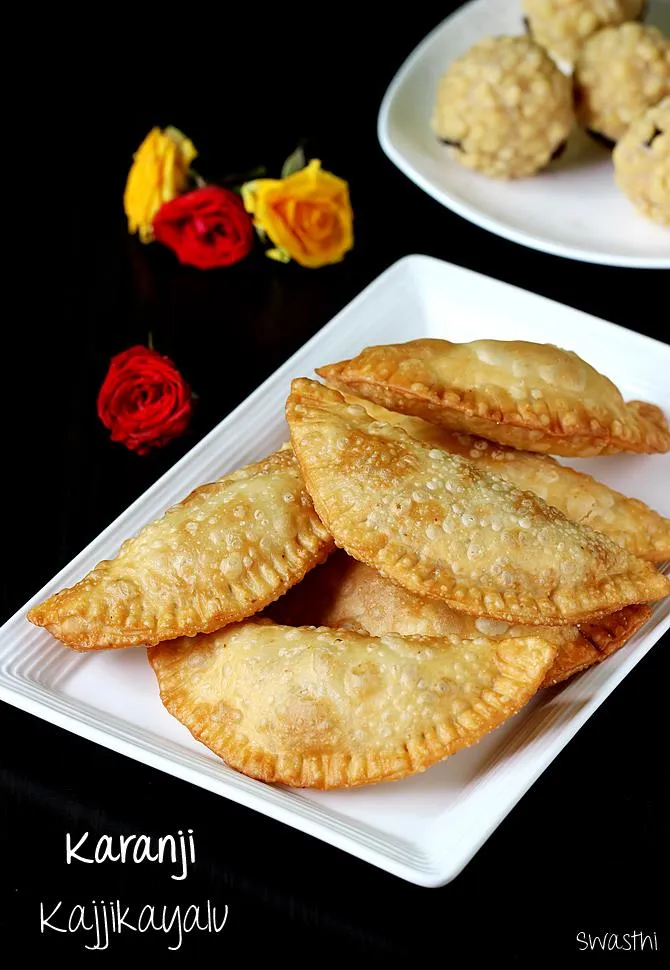
Pro Tips
Coconut: Traditionally dried coconut also known as copra is used. It is not the same as desiccated coconut or powdered coconut. You may use more quantity of desiccated coconut or fresh coconut but they don’t taste the same. Also the flavor is very different. With fresh coconut karanji won’t keep good for long.
Sugar / Jaggery: For the sweetener sugar works best, if using jaggery we add a few tablespoons of fried gram flour (Roasted chana dal flour/ chutney dal flour).
Poppy seeds: I don’t use poppy seeds as they are not available in the Country I live. You may leave out that or use sesame seeds.
Ghee: The quantity of ghee is what decides the texture of your karanji covering. I have made these recently with more amount of ghee and got better results than before. So I updated my old recipe with a little more ghee.
Dough: Remember not to make the dough too soft or sticky. Karanji will soak up oil while frying.
Related Recipes
Recipe Card

Karanji Recipe (Kajjikayalu)
For best results follow the step-by-step photos above the recipe card
Ingredients (US cup = 240ml )
For the filling
- 1 teaspoon ghee
- ½ cup dried coconut grated copra or desiccated coconut
- ¼ cup cashews or mixed nuts. chopped
- ½ cup sugar (or jaggery powder, adjust to taste)
- 1 tablespoon poppy seeds (optional)
- ⅓ teaspoon cardamom powder / elaichi
For the outer covering
- 1 cup all-purpose flour (organic maida)
- 2 tablespoons semolina / fine rava
- 2 tablespoons ghee hot
- 1 Pinch salt
- ⅓ cup warm water (use only as needed)
For Frying
- oil as required
Instructions
Make Dough
- To a mixing bowl, add flour, semolina, salt and hot ghee. (Heat ghee in a kadai and pour it here.) Mix everything well with a spoon first and then with fingers.
- Pour warm water little by little to make a stiff and non-sticky dough. Start with ¼ cup water and add more as required.
- Cover and set aside till the filling is ready.
Make Filling
- Heat a pan with 1 teaspoon ghee and fry cashews until light golden.
- Add coconut and saute until a nice aroma comes out. This takes just 1 to 2 mins. Add cardamom powder and nutmeg (optional). If using poppy seeds you can add them now and saute for just 1 minute until they turn crunchy.
- Turn off and transfer this to a plate/ bowl to cool. Meanwhile add sugar to a grinder and make a fine powder.
- When the coconut cools down completely, add the sugar and mix well. For a less sweeter karanji, you may start with lesser sugar, taste test and add more as needed.
How to Make Karanji
- Divide the dough to 8 equal parts and keep them covered. Begin to roll the balls gently to small puris of about 4 to 5 inches. It should be neither too thick not too thin.
- If you do not get round shapes, use a round cookie cutter, pastry cutter or a lid of a steel jar and cut to round shaped puris.
- Add 1½ to 2 tbsps. mixture to these center of the puri. Dip your finger in a bowl of water and smear the water around the edge of the puri.
- Join the edges to make a semi circle shaped karanji. Make sure you press down well and the edges stick up well.
- With the help of a fork make light incisions to get a design.
- Heat oil in a kadai for deep frying on a medium flame.
- To test if it is hot enough, drop a small portion of the dough to the oil. If the oil is ready for frying, the dough will sizzle and rise up to the surface. If it is not ready it will sink. Also the dough should not brown which means it is too hot.
- When the oil is just right – medium hot, add the karanji one after the other. Do not disturb them for 2 minutes.
- When they firm up, turn them to the other side and fry until crisp and golden. Remember that karanji should be fried on a medium heat else they won't turn crispy.
- Cool karanji completely and store in a airtight jar.
NUTRITION INFO (estimation only)
© Swasthi’s Recipes
About Swasthi
I’m Swasthi Shreekanth, the recipe developer, food photographer & food writer behind Swasthi’s Recipes. My aim is to help you cook great Indian food with my time-tested recipes. After 2 decades of experience in practical Indian cooking I started this blog to help people cook better & more often at home. Whether you are a novice or an experienced cook I am sure Swasthi’s Recipes will assist you to enhance your cooking skills. More about me
Follow Swasthi’s Recipes

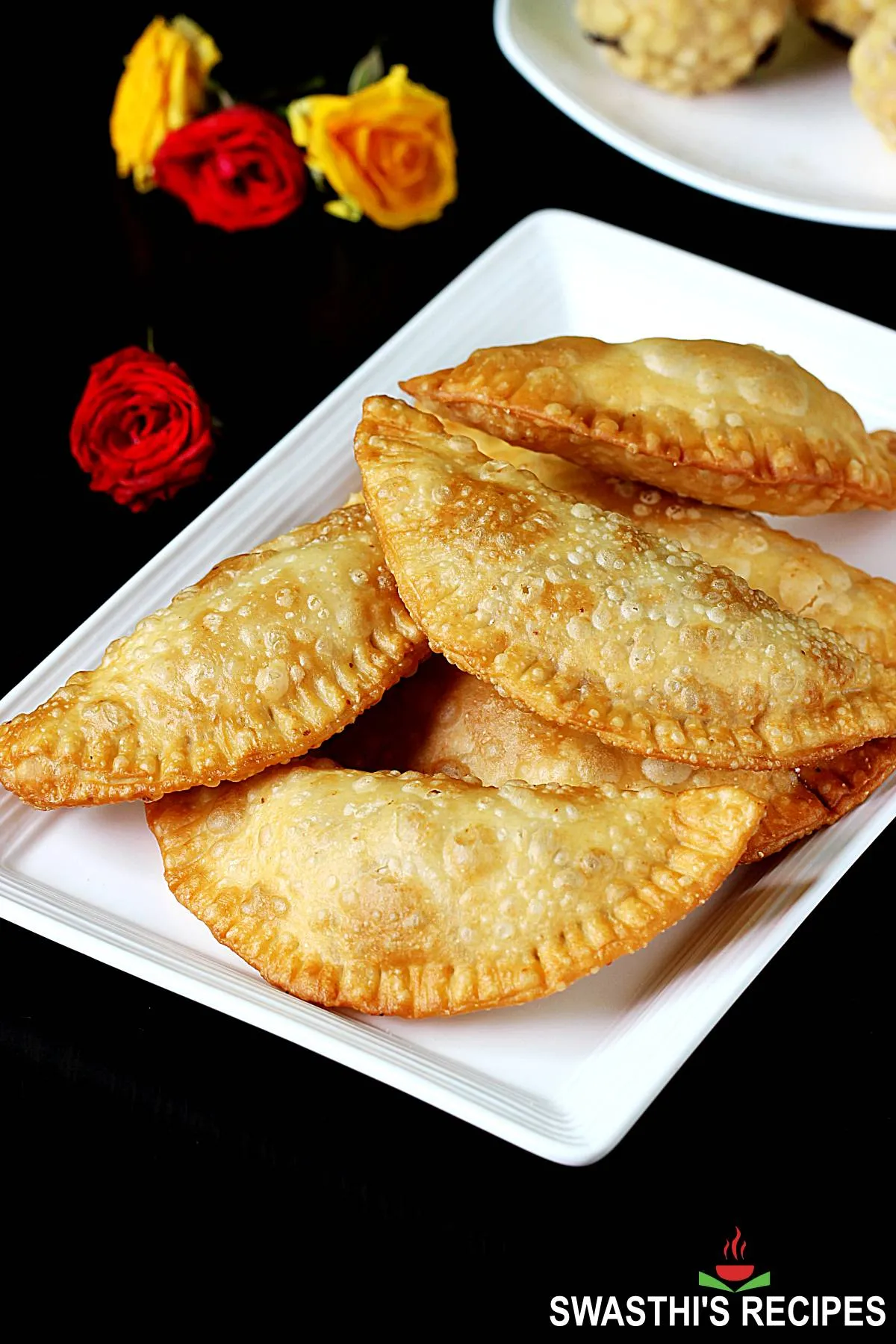
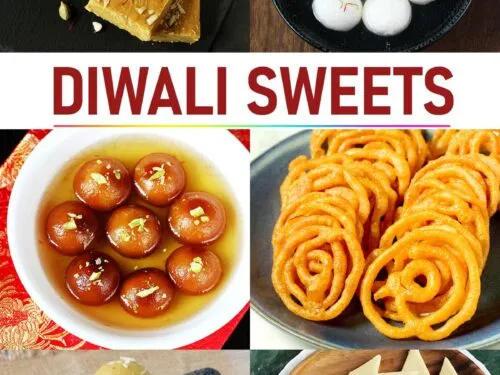
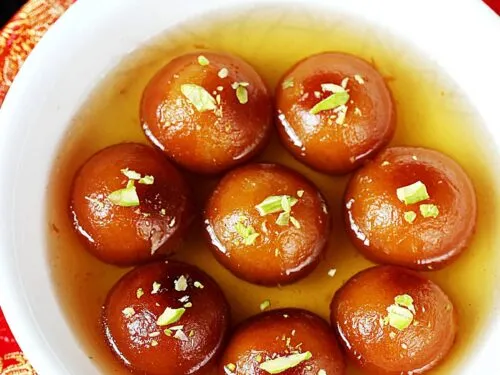
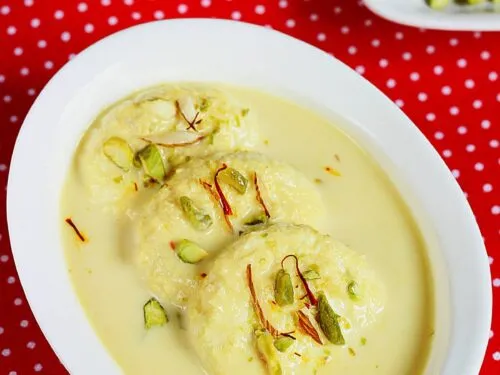
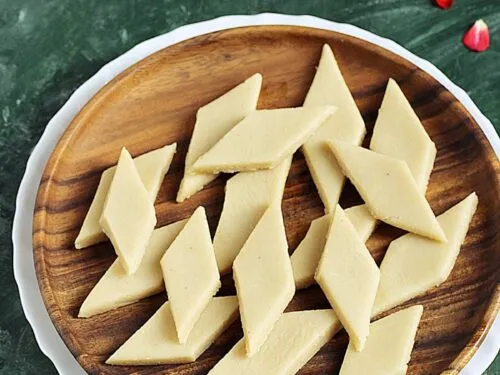
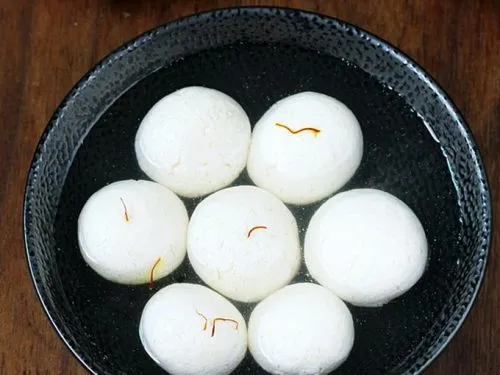
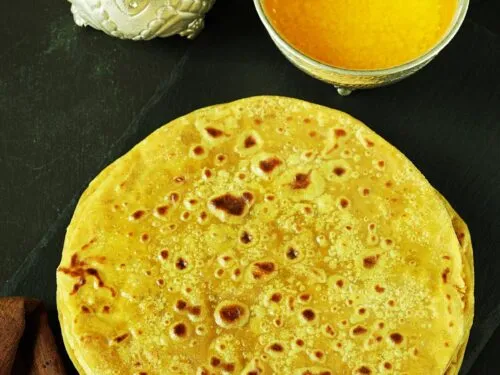
Comments
Came out really well. I did it as Margali prasadam using exact measurements without tasting it.
I’m happy about the outcome, Thank you mam❣️!
Glad to know Kiruthika
Thank you
How long would these stay fresh in a tight tin or Ziploc?
Can i use wheat flour for outer covering?
HI Lakshmi
with wheat flour they will turn hard and the covering will be very thick.
Hi Swasthi
I tried the butter paneer and it was a hit,
Loved by everyone.
Thanks for the lovely recipe.
I am following your recipes….cameout very well…especially murukulu….thank u for sharing such tasty recipes…
Welcome Yashoda
Thanks for sharing the outcome
I follow your site religiously and I love your recipes. Every recipe I tried came out well. The information you provide is very useful. And I love ur site and the pics and the appearance of your site. Very well organised. Hats off to you,
Hello Swathi
Thanks a lot for following. Really very happy to know the recipes turned out good.
🙂
I ALWAYS WANT TO KNOW HOW TO MAKE SAMOSA LIKE THEY SELL IN MARKETS BUT ONLY PROBLEM IS MY SAMOSA ALWAYS GETS SOFT AFTER FEW MINUTES. CAN YOU TELL ME HOW OR WHAT SHOULD I USE
Hi Ranjana
You can follow this recipe of samosa
Hai swathi, thanks for the recipe. I love the kajikayalu. I want chilimidi recipe can u post this recipe. Wish happy Deepavali you and your family
Hi Shashi
You are welcome. Wish you all too a very happy Deepavali. I have 2 recipes of chalimidi. One is the raw one made for naivedhyam and the other other is pakam chalimidi. You can find the recipe of raw chalimidi here and pakam chalimidi here. I do not have the step by step pictures, you can find the recipe towards the end of the post. Hope this helps
Looks so sweet. i love karanjii. Thanks for the recipe.
Welcome Vidya